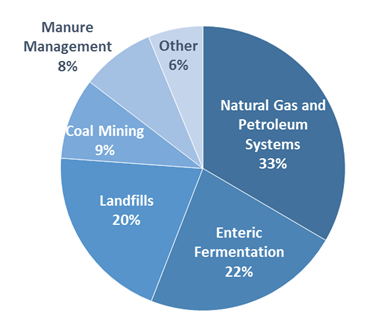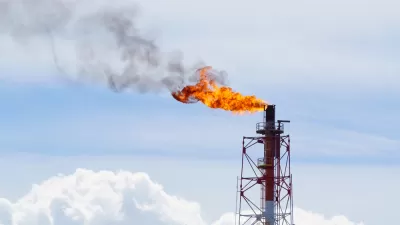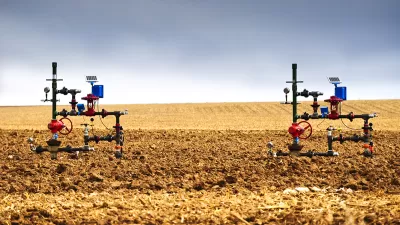While the methane reduction targets are the same as the draft rule released last August (i.e., 40-45 percent reduction of 2012 levels by 2025), the new rule removes exceptions, resulting in a 30 percent improvement in reductions of methane.

A new methane rule is an essential part of President Obama's climate initiative. Finalized on May 12, it is designed to cut methane emissions from the oil and natural gas sector, and is considerably stronger than the one proposed last summer.
"The agency also said it is kicking off work on a rule for methane leaks at existing wells, but acknowledged that won’t come until after Obama has left office," writes Devin Henry, energy and environment reporter at The Hill.
Methane (CH4) is second most prevalent greenhouse gas emission, after carbon dioxide. "Methane's lifetime in the atmosphere is much shorter than carbon dioxide (CO2), but CH4 is more efficient at trapping radiation than CO2," according to the Environmental Protection Administration. "Pound for pound, the comparative impact of CH4 on climate change is more than 25 times greater than CO2 over a 100-year period."
The new rule removed "exceptions for low-producing wells, expanding leak monitoring and requiring quicker repairs for leaks," explains Henry. "If fully implemented, it will reduce 520,000 short tons of methane in 2025, or the equivalent of 11 million metric tons of carbon dioxide. The EPA’s proposed rule would have cut up to 400,000 short tons of methane."
The rule will apply to the source of one third of the anthropogenic (man-made) methane emissions in the United States. Enteric fermentation, resulting from the digestive systems of domestic livestock, are second at 22 percent, though globally it is 28 percent. Landfills are next at 20 percent, followed by coal mines at 9 percent, and manure management at 8 percent (thus agriculture would account for 30 percent).
Pie Chart from EPA's Overview of Greenhouse Gases: [Anthrogenic] methane emissions

Note: All emission estimates from the Inventory of U.S. Greenhouse Gas Emissions and Sinks: 1990-2014.
It's important to bear in mind that natural sources, such as decomposition occurring in wetlands, account for almost 40 percent of total global CH4 emissions.
The new rule will enable President Obama to meet an agreement he made with Canadian Prime Minister Justin Trudeau in March.
"Earthjustice, which represents green causes in legal cases, said it “will defend this rule in court when the oil and gas industry tries to weaken it," adds Henry.
Air pollution as well as greenhouse gas emission reduction
"The standards also are expected to reduce 210,000 short tons of ozone-forming , volatile organic compounds (VOCs) in 2025, along with 3,900 tons of air toxics, such as benzene, toluene, ethylbenzene and xylene," states EPA's press release.
To access the final rule and fact sheets, including an overview and summaries of specific requirements for different segments of the oil and gas industries, click here.
Hat tip to Alan Drake, via Sierra Club energy forum.
FULL STORY: EPA finalizes stronger methane emission rules

Planetizen Federal Action Tracker
A weekly monitor of how Trump’s orders and actions are impacting planners and planning in America.

Map: Where Senate Republicans Want to Sell Your Public Lands
For public land advocates, the Senate Republicans’ proposal to sell millions of acres of public land in the West is “the biggest fight of their careers.”

Restaurant Patios Were a Pandemic Win — Why Were They so Hard to Keep?
Social distancing requirements and changes in travel patterns prompted cities to pilot new uses for street and sidewalk space. Then it got complicated.

Platform Pilsner: Vancouver Transit Agency Releases... a Beer?
TransLink will receive a portion of every sale of the four-pack.

Toronto Weighs Cheaper Transit, Parking Hikes for Major Events
Special event rates would take effect during large festivals, sports games and concerts to ‘discourage driving, manage congestion and free up space for transit.”

Berlin to Consider Car-Free Zone Larger Than Manhattan
The area bound by the 22-mile Ringbahn would still allow 12 uses of a private automobile per year per person, and several other exemptions.
Urban Design for Planners 1: Software Tools
This six-course series explores essential urban design concepts using open source software and equips planners with the tools they need to participate fully in the urban design process.
Planning for Universal Design
Learn the tools for implementing Universal Design in planning regulations.
Heyer Gruel & Associates PA
JM Goldson LLC
Custer County Colorado
City of Camden Redevelopment Agency
City of Astoria
Transportation Research & Education Center (TREC) at Portland State University
Camden Redevelopment Agency
City of Claremont
Municipality of Princeton (NJ)




























